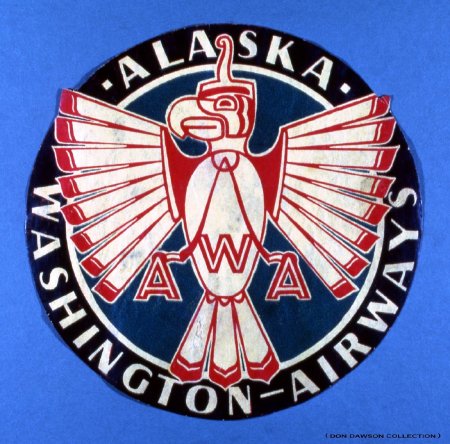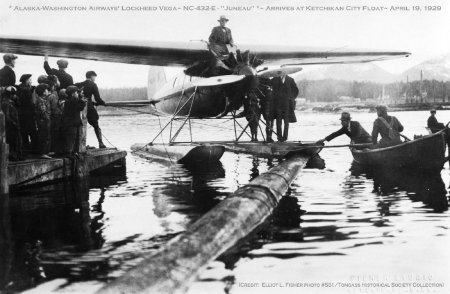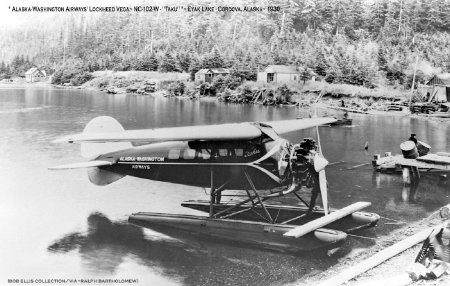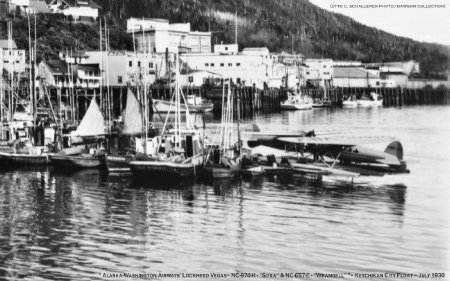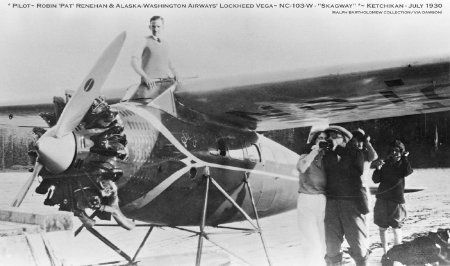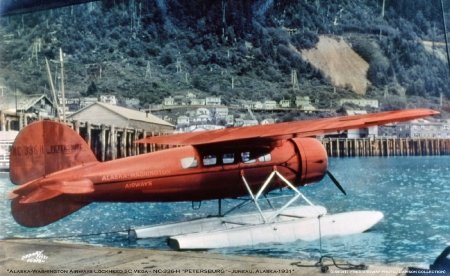Description:
Alaska-Washington Airways, 1929-1932
Southeast Alaska's commercial aviation really blossomed during the spring of 1929. On the heels of International Airways' Boeing flying boat charter survey flight to Ketchikan and Juneau that March, came the historic arrival of owner Joe Carman Jr.'s Seattle based Alaska-Washington Airways' modern Lockheed Vega 5C floatplanes, powered by reliable air-cooled radial engines. On April 15, 1929, Alaska-Washington Airways made the first non-stop flight from Seattle to Juneau inaugurating the company's ambitious air charter operations in the Panhandle region. Chief pilot Anscel Eckmann, accompanied by co-pilot/navigator R. E. 'Bob' Ellis and mechanic Jack Halloran, completed the 940 mile flight to Juneau in seven hours and thirty-five minutes, flying the Vega appropriately dubbed the "Juneau" (NC432E). They flew over Ketchikan at 12:53 p.m. and landed in Juneau harbor an hour later. Carrying same day edition copies of Seattle newspapers, it well demonstrated the great potential for airmail service for Alaska.
For a professional appearance, Alaska-Washington Airways pilots wore full navy style dress uniforms with a flight mechanic aboard as crew. The airplanes, mounted on Edo Mod. 4650 pontoon floats, were uniformly painted in attractive dark blue and cream schemes. Charter rate was $44/hr. for moving passengers and freight. Twice-weekly scheduled flights to Seattle were also offered. Fish trap and cannery patrol duties were very lucrative, along-with mining, hunting, and fishing charters. Using their two Vegas "Juneau" and "Ketchikan", Alaska-Washington Airways carried more than 1,500 passengers during the five months of the 1929 season (4/15/29 - 9/21/29).
Capitalizing on their great early achievements, Alaska-Washington Airways augmented their fleet to six different Vegas in Southeast Alaska for the 1930 season. Each plane was named after Panhandle towns: "Juneau" (NC432E), "Taku" (NC102W), "Skagway" (NC103W), "Wrangell" (previously named "Ketchikan" NC657E), "Sitka" (NC974H) and "Petersburg" (NC336H). The "Wrangell" and "Petersburg" sported bright new flashy deep orange schemes. Full NACA speed engine cowlings were fitted onto some of the Vegas. Alaska-Washington Airways constructed seaplane maintenance floating hangars that summer in Ketchikan and Juneau. One-way ticket fare from Seattle to Ketchikan was $75 and $135 roundtrip (4 hr. 30 min. flight). One-way ticket fare from Seattle to Juneau was $105 and $189 roundtrip. In July, RKO Film Studios chartered the Vega "Skagway" for on location shooting logistics on their Rex Beach saga film production "The Silver Horde" in Ketchikan and Loring. Strong steady business allowed the Vegas to extend seasonal operations into that fall.
Fate impacted Alaska-Washington Airways' fortunes on October 28, 1930 when the Vega "Skagway" went missing with three aboard while flying from Seattle to Ketchikan in bad weather and darkening skies. The Vega "Taku" was previously written off on October 4, 1930 due to fire, following a precautionary water landing outside Hood Canal near Kingston, Washington. Three Alaska-Washington Airways Vegas returned for the 1931 season: "Petersburg", "Sitka", and "Wrangell". In December 1931, fishing cannery baron Nick Bez announced purchase of Alaska-Washington Airways' assets (Vega "Petersburg" and the Juneau hangar), to form Alaska Southern Airways with Anscel Eckmann as Vice President. Alaska-Washington Airways held a receivers sale of its remaining assets in Seattle in March 1932.
Aircraft Specifications:
Lockheed 5C Vega Seaplane on Edo Mod. 4650 floats. 1927 High-wing monoplane design. First Flight: 7/4/27. 64 Mod. 5Cs built, 132 built (all variants). Construction: Wooden monocoque fuselage (wood ribs), laminated plywood-construction, single-spar cantilever wings, with fabric-covered flying surfaces. Dimensions: Length: 27' 6"; Height: 8' 6" (Landplane); Wingspan: 41' 9"; Wing Area: 275 sq. ft. Weights: Standard Empty Weight: 3,153 lbs.; Gross Weight: 4,880 lbs.; Useful Load: 1,000 lbs. Fuel Capacity: 160 gal. Performance: Airspeed: 160 mph cruise, 175 mph max; Service Ceiling: 17,000 ft.; Rate of Climb: 1,100 ft. per min.; Range: 620 mi. (Note: Performance figures with NACA Cowling). Engine: Air-cooled 9 Cylinder 450 hp Pratt and Whitney R-1340 Wasp SC1. Propeller: Hamilton Standard 2-Blade Fixed-Pitch. Occupancy: Pilot: 1; Passengers: 5-7.
Pilots:
Anscel Eckmann, Bob Ellis, Pat Renehan, Clark Wing, Gene Meyring, and Floyd Keadle.
Mechanics:
Jack Halloran, Frank Hatcher, Brian Harland, Frank Wadman, Chandler Hicks, Gordon Graham, Bert Seaton, John Selby, and Burras Smith.
For a professional appearance, Alaska-Washington Airways pilots wore full navy style dress uniforms with a flight mechanic aboard as crew. The airplanes, mounted on Edo Mod. 4650 pontoon floats, were uniformly painted in attractive dark blue and cream schemes. Charter rate was $44/hr. for moving passengers and freight. Twice-weekly scheduled flights to Seattle were also offered. Fish trap and cannery patrol duties were very lucrative, along-with mining, hunting, and fishing charters. Using their two Vegas "Juneau" and "Ketchikan", Alaska-Washington Airways carried more than 1,500 passengers during the five months of the 1929 season (4/15/29 - 9/21/29).
Capitalizing on their great early achievements, Alaska-Washington Airways augmented their fleet to six different Vegas in Southeast Alaska for the 1930 season. Each plane was named after Panhandle towns: "Juneau" (NC432E), "Taku" (NC102W), "Skagway" (NC103W), "Wrangell" (previously named "Ketchikan" NC657E), "Sitka" (NC974H) and "Petersburg" (NC336H). The "Wrangell" and "Petersburg" sported bright new flashy deep orange schemes. Full NACA speed engine cowlings were fitted onto some of the Vegas. Alaska-Washington Airways constructed seaplane maintenance floating hangars that summer in Ketchikan and Juneau. One-way ticket fare from Seattle to Ketchikan was $75 and $135 roundtrip (4 hr. 30 min. flight). One-way ticket fare from Seattle to Juneau was $105 and $189 roundtrip. In July, RKO Film Studios chartered the Vega "Skagway" for on location shooting logistics on their Rex Beach saga film production "The Silver Horde" in Ketchikan and Loring. Strong steady business allowed the Vegas to extend seasonal operations into that fall.
Fate impacted Alaska-Washington Airways' fortunes on October 28, 1930 when the Vega "Skagway" went missing with three aboard while flying from Seattle to Ketchikan in bad weather and darkening skies. The Vega "Taku" was previously written off on October 4, 1930 due to fire, following a precautionary water landing outside Hood Canal near Kingston, Washington. Three Alaska-Washington Airways Vegas returned for the 1931 season: "Petersburg", "Sitka", and "Wrangell". In December 1931, fishing cannery baron Nick Bez announced purchase of Alaska-Washington Airways' assets (Vega "Petersburg" and the Juneau hangar), to form Alaska Southern Airways with Anscel Eckmann as Vice President. Alaska-Washington Airways held a receivers sale of its remaining assets in Seattle in March 1932.
Aircraft Specifications:
Lockheed 5C Vega Seaplane on Edo Mod. 4650 floats. 1927 High-wing monoplane design. First Flight: 7/4/27. 64 Mod. 5Cs built, 132 built (all variants). Construction: Wooden monocoque fuselage (wood ribs), laminated plywood-construction, single-spar cantilever wings, with fabric-covered flying surfaces. Dimensions: Length: 27' 6"; Height: 8' 6" (Landplane); Wingspan: 41' 9"; Wing Area: 275 sq. ft. Weights: Standard Empty Weight: 3,153 lbs.; Gross Weight: 4,880 lbs.; Useful Load: 1,000 lbs. Fuel Capacity: 160 gal. Performance: Airspeed: 160 mph cruise, 175 mph max; Service Ceiling: 17,000 ft.; Rate of Climb: 1,100 ft. per min.; Range: 620 mi. (Note: Performance figures with NACA Cowling). Engine: Air-cooled 9 Cylinder 450 hp Pratt and Whitney R-1340 Wasp SC1. Propeller: Hamilton Standard 2-Blade Fixed-Pitch. Occupancy: Pilot: 1; Passengers: 5-7.
Pilots:
Anscel Eckmann, Bob Ellis, Pat Renehan, Clark Wing, Gene Meyring, and Floyd Keadle.
Mechanics:
Jack Halloran, Frank Hatcher, Brian Harland, Frank Wadman, Chandler Hicks, Gordon Graham, Bert Seaton, John Selby, and Burras Smith.
Click to Enlarge

